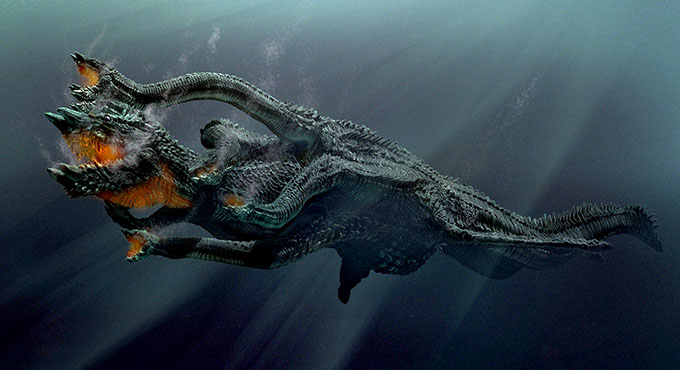
Leviathan, the sea dragon of chaos, as he is depicted in the novel series, Chronicles of the Nephilim by Brian Godawa. Available at Amazon.
In the previous post, I talked about how the pagan Canaanite Storm God, Ba’al was subverted by the Bible. The Biblical writers appropriated the language of storm and applied it to Yahweh in effect to claim that Ba’al was not the god of Storm, Yahweh was. But that’s not all. The Canaanite mythology contained a narrative of Ba’al fighting with Leviathan, the sea dragon of chaos. Well, guess what, the Bible subverts that too.
The Dragon and the Sea
In ancient Near Eastern religious mythologies, the sea and the sea dragon were symbols of chaos that had to be overcome to bring order to the universe, or more exactly, the political world order of the myth’s originating culture. Some scholars call this battle Chaoskampf—the divine struggle to create order out of chaos.[1] Creation accounts were often veiled polemics for the establishment of a king or kingdom’s claim to sovereignty.[2] Richard Clifford quotes, “In Mesopotamia, Ugarit, and Israel the Chaoskampf appears not only in cosmological contexts but just as frequently—and this was fundamentally true right from the first—in political contexts. The repulsion and the destruction of the enemy, and thereby the maintenance of political order, always constitute one of the major dimensions of the battle against chaos.”[3]
For example, the Sumerians had three stories where the gods Enki, Ninurta, and Inanna all destroy sea monsters in their pursuit of establishing order. The sea monster in two of those versions, according to Sumerian expert Samuel Noah Kramer, is “conceived as a large serpent which lived in the bottom of the ‘great below’ where the latter came in contact with the primeval waters.”[4] In the Babylonian creation myth, Enuma Elish, Marduk battles the sea dragon goddess Tiamat, and splits her body into two parts, creating the heavens and the earth, the world order over which Babylon’s deity Marduk ruled.

Artwork from the Marvel movie, “The Avengers.” Hey, wait a minute. Is that Hulk or Baal crushing the head of Leviathan? The artists of Marvel even called the beast “Leviathan.”
Another side-by-side comparison of those same Ugaritic passages that we considered above with other Old Testament passages reveals another common narrative: Yahweh, the charioteer of the clouds, metaphorically battles with Sea (Hebrew: yam) and River (Hebrew: nahar), just as Baal struggled with Yam and Nahar, which is also linked to victory over a sea dragon/serpent.
UGARTIC TEXTS‘Dry him up. O Valiant Baal!
What manner of enemy has arisen against Baal, |
OLD TESTAMENTDid Yahweh rage against the rivers (nahar) In that day Yahweh will punish Leviathan the fleeing serpent, “You divided the sea by your might; |
Baal fights Sea and River to establish his sovereignty as charioteer of the clouds. He wins by drinking up Sea and River, draining them dry, and thus establishing his supremacy over the pantheon and the Canaanite world order.[6] In the same way, the Bible describes Yahweh as raging against Sea and River on his cloud chariot. In the second Canaanite passage, Baal’s battle with Sea and River is retold in other words as a battle with a “dragon,” the “writhing serpent” with seven heads.[7] Another Baal text calls this same dragon, “Lotan, the wriggling serpent.”[8] The Hebrew equivalents of the Ugaritic words tannin (dragon) and lotan are tannin (dragon) and liwyatan (Leviathan) respectively.[9] This is the same exact description that the Bible uses of Yahweh battling the “fleeing and twisted” sea serpent Leviathan, whose multiple heads (plural), Yahweh crushed at the Red Sea incident.[10]
And notice as well the reference to the Red Sea event also associated with Leviathan in the Biblical text. In Psalm 74 above, God’s parting of the waters is connected to the motif of the Mosaic covenant as the creation of a new world order in the same way that Baal’s victory over the waters and the dragon are emblematic of his establishment of kingdom authority in the Canaanite pantheon. This covenant motif is described as a Chaoskampf battle with the Sea and Leviathan (also called Rahab) in several other significant Biblical references as well.[11]
For a free article that examines Leviathan of the Bible in more detail, see my “Leviathan: Sea Dragon of Chaos” Here.
Leviathan is a major character in the entire Chronicles of the Nephilim series.
[1] Hermann Gunkel first suggested this theme in Schöpfung und Chaos in Urzdt und Endzeit (1895).
[2] Bruce R. Reichenbach, “Genesis 1 as a Theological-Political Narrative of Kingdom Establishment,” Bulletin for Biblical Research 13, 1 (2003).
[3] Clifford, Creation Accounts, 8, n. 13.
[4] Samuel Noah Kramer, Sumerian Mythology: A Study of Spiritual and Literary Achievement in the Third Millennium B.C. (Philadelphia: University of Pennsylvania Press, 1944, 1961, 1972), 77-78.
[5] “Charioteer of the Clouds” also appears in these texts: KTU 1.3:4:4, 6, 26; 1.4:3:10, 18; 1.4:5:7, 60; 1.10:1:7; 1.10:3:21, 36; 1.19:1:43; 1.92:37, 39.
[6] KTU 1.2:4:27-32.
[7] See KTU 1.5:1:1-35.
[8] KTU 1.5:1:1-4.
[9] Walter C. Kaiser, Jr., The Ugaritic Pantheon (dissertation) (Ann Arbor, MI: Brandeis University, 1973), 212.
[10] See also Isaiah 51:9; Ezekiel 32:2; Revelation 12:9, 16, 17.
[11] Psalm 89:9-10; Isaiah 51:9-10; Job 26:12-13. Psalms 18, 29, 24, 29, 65, 74, 77, 89, 93, and 104 all reflect chaoskampf. See also Exodus 15, Job 9, 26, 38, and Isaiah 51:14-16; 2 Samuel 22.


6 comments on “Of Myth and the Bible – Part 4: Leviathan, Sea Dragon of Chaos”
Hi,
Would you mind if I use the picture of Leviathan to accompany my pastor’s message this Sunday?
Karen,
Yes you may. When he shows it, I’m sure people will be fascinated by it and wonder where he got it. So please tell him it was from Godawa.com in case anyone asks. Thanks!
Thank you so much! I will definitely give you credit for the photo.
Very informative blog.Really looking forward to read more. Awesome.
Comments are closed.